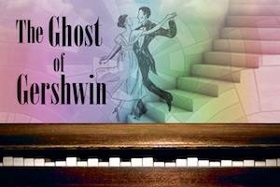THE GHOST OF GERSHWIN: SONGS 10, BOOK 3
There is a lot to sing about in the Group Rep’s season closer The Ghost of Gershwin. It contains a bevy of freshly penned ditties by Wayland Pickard (music) and Laura Manning (lyrics co-written with Pickard) that are nostalgic in tone and capture the style and essence of a bygone era perfectly. Doug Haverty’s book, however, is another story: Even with promising elements, the entire libretto needs to be banished to the boneyard and born anew if this world premiere musical expects to scare up much future interest.
An homage to a simpler time when lighthearted, lightweight entertainment such as Girl Crazy and Anything Goes ruled the Great White Way, The Ghost of Gershwin takes place in a present-day Brooklyn apartment building populated by artsy types of every ilk. Grant (Andrew Bourgeois), a struggling composer with an obsession for the music of George Gershwin, has been in a creative rut since his triple-threat 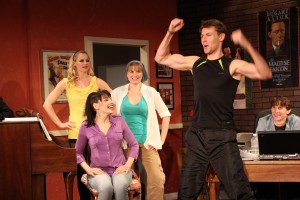 fiancé Nessa (Emma-Jayne Appleyard) abandoned him at the alter for Dennis (Gregory Guy Gorden), his best friend and business partner.
fiancé Nessa (Emma-Jayne Appleyard) abandoned him at the alter for Dennis (Gregory Guy Gorden), his best friend and business partner.
Everyone wants something from Grant. Dennis wants him to write music he can actually sell. Nessa and her choreographer Wilfred (Kyle Bares) need him to write a song for an upcoming audition. Building manager and wannabe chanteuse Coronelia (Suzy London) wants the past-due rent but will settle for a song into which she can pour her heartache. Tile and grout worker Mel (Jean Altadel), who happens to be a closet cabaret performer, needs not only an anthem but love as well. She is the perfect match for Grant but he of course can’t see it’”yet. He sets out to give everyone everything they need. He has no problem coming up with the melodies but the lyrics escape him. Enter a possessed piano and the ghost of Gershwin (Daniel Lench) to help him find his way.
As with the musicals of yesteryear, this convoluted plotting is just one big set-up for everyone to break out into song and dance at the drop of a hat. One character starts singing a song never heard before and says “C’mon gang, back me up”; instantaneously through the miracle of musical osmosis they all know the words and dance steps and put on a show. It’s a conceit that can work when handled properly, but here it comes off as forced and false.
In addition, for some unknown reason, many of the numbers end in a blackout as if it were time to take a commercial break. If these were buttons to another scene this would make sense, but they’re not and the audience expects the action to continue. Instead it’s on to the next feeble excuse for another spontaneous eruption of musical merriment. Whereas the story in Act I attempts to justify the numbers, Act II is a 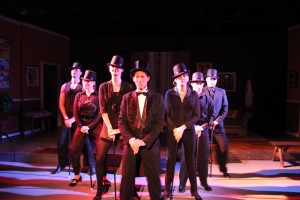 cavalcade of crooning for crooning sake. If this were an “and then I wrote” jukebox review, that would be fine, but it’s not, so the songs need raisons d’être.
cavalcade of crooning for crooning sake. If this were an “and then I wrote” jukebox review, that would be fine, but it’s not, so the songs need raisons d’être.
The shortcomings in the book are a real shame because for the most part the tunes are terrific. They’re melodic with catchy and clever lyrics that are totally reminiscent of the Gershwin style with a little Harold Arlen and Cole Porter thrown in for good measure. “Time,” “Tap, Happy Feet,” and “Crazy Melody” among many others sound as if plucked straight out of the 1930s. Of the 17 new songs only 2 (“The Blues” and “Life All Around Us”’”even though they are wonderful tunes in their own right) seem out of place. If only they could find their way into a better show.
The cast is at best inconsistent under Jules Aaron’s direction. There are shining moments, but yet again a Los Angeles theater cast a musical with actors who aren’t the strongest singers’”there isn’t a single cast member who doesn’t veer completely off key at one point or another. (All of the songs are performed to pre-recorded tracks). The solos and duets have the least “flat-ulence,” while the over-choreographed group numbers often leave the actors short of breath and short of 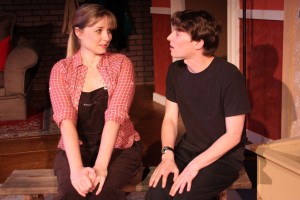 pitch. A few times, the harmonies were so grating that it sent shivers down my spine.
pitch. A few times, the harmonies were so grating that it sent shivers down my spine.
The women fare better than the men and make the most out of Mr. Haverty’s dialogue; they also have have better voices. The pleasant Ms. Altadel does a bang up job with her torch song, “The Blues.” In a less than sympathetic role, the equally worthy Ms. Appleyard has a terrific dance solo. Ms. London has a good grasp of the love-starved lonely widow and touches the hearts of all with her rendition of “After All This Time.”
Mr. Bourgeois has a tough job as Grant. Through no fault of his own, he’s only partially successful in making sense of Mr. Haverty’s mess. His short and slight stature makes for some interesting stage pictures when paired with Ms. Appleyard, who towers over him and looks like she could easily go all “praying mantis” on him at any time.
Had the script not mentioned (on several occasions) that Gershwin died at 38, it wouldn’t have mattered that Mr. Lench, a bit long in the tooth for the role, looks more like Gershwin’s father. Still, he admirably shows himself to be quite the song and dance man. As Dennis, Mr. Gorden has a tendency for excessive mugging along the lines of Gig Young and Tony Randall, but proves to be a real crowd pleaser with his overblown takes and reactions. The adept Mr. Bares adds a nice touch of eye 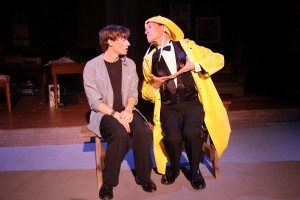 candy as dancemaker Wilfred, although his big Act I number “Spice Guy” was a disappointment, starting out strong but ultimately falling apart. He redeemed himself with “Something Sleeping,” a touching love song.
candy as dancemaker Wilfred, although his big Act I number “Spice Guy” was a disappointment, starting out strong but ultimately falling apart. He redeemed himself with “Something Sleeping,” a touching love song.
Choreographer Michele Bernath worked overtime and should have shown a bit more restraint. It makes sense to have a number choreographed within an inch of its life for the first and second act openers (and Bernath delivered), but it isn’t always necessary to have the actors dancing throughout an entire number. She mixes up her styles quite a bit from tap to jazz to Rockettes-style kick lines, which creates a nice variety for the viewer.
Chris Winfield and Mr. Aaron’s stagnant apartment set’”complete with a large downstage rock patio perfect for staging dance numbers’”serves the show well and never grows tiresome during the 150-minute musical, thanks in part to J. Kent’s 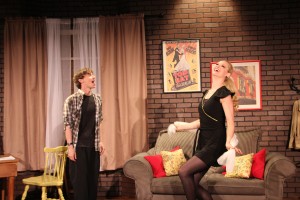 Inasy’s soothing and appropriate lighting. Most of the costumes are everyday street clothes, but in a few instances Angela M. Eads pulls out the stops and goes wild with sequins and splashes of color.
Inasy’s soothing and appropriate lighting. Most of the costumes are everyday street clothes, but in a few instances Angela M. Eads pulls out the stops and goes wild with sequins and splashes of color.
This is clearly a work in progress and the Group Rep has made a valiant effort in its first mounting. Now that it’s on its feet, it will be easier to see what does and doesn’t work. With a little restructuring and a new book, they could have a real winner on their hands’”a new old-fashioned musical that even the ghost of Gershwin would be proud to call his own.
photos by Sherry Netherland
The Ghost of Gershwin
The Group Rep
Lonny Chapman Theatre
10900 Burbank Blvd. in North Hollywood
Fri – Sat at 8:00 pm, Sun at 2:00 pm
scheduled to end on June 22, 2014
for tickets, call (818) 763-5990 or visit www.thegrouprep.com
